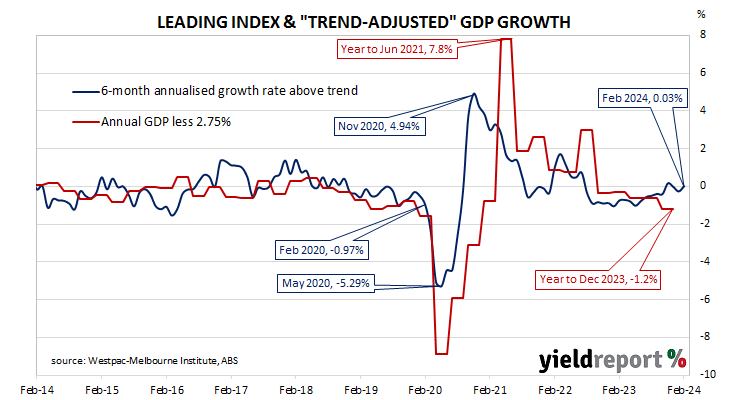Summary: Leading index growth rate up in February; continues to show signs of improving; reading implies annual GDP growth of around 2.75%; ACGB yields fall; rate-cut expectations soften a touch; recent readings broadly consistent with more-stable growth profile emerging later this year.
Westpac and the Melbourne Institute describe their Leading Index as a composite measure which attempts to estimate the likely pace of Australian economic growth in the short-term. After reaching a peak in early 2018, the index trended lower through 2018 and 2019 before plunging to recessionary levels in the second quarter of 2020. Subsequent readings spiked towards the end of 2020 but then trended lower through 2021 and 2022 before flattening out in 2023.
February’s reading has now been released and the six month annualised growth rate of the indicator registered +0.03%, up from January’s figure of -0.25%.
“The Leading Index growth rate continues to show signs of improving, hovering around the zero ‘gain line’ over the last four months following fifteen consecutive months of negative, below trend reads,” said Westpac senior economist Matthew Hassan.
Index figures represent rates relative to “trend” GDP growth, which is generally thought to be around 2.75% per annum in Australia. The index is said to lead GDP by “three to nine months into the future” but the highest correlation between the index and actual GDP figures occurs with a three-month lead. The current reading is thus indicative of an annual GDP growth rate of around 2.75% in the next quarter.
Domestic Treasury bond yields fell on the day. By the close of business, 3-year and 10-year ACGB yields had both lost 2bps to 3.58% and 4.02% respectively while the 20-year yield finished 4bps lower at 4.32%.
In the cash futures market, expectations regarding rate cuts later this year softened a touch. At the end of the day, contracts implied the cash rate would remain close to the current rate for the next few months and average 4.315% through April, 4.295% in May and 4.275% in June. However, August contracts implied a 4.16% average cash rate, November contracts implied 3.985%, while February contract implied 3.82%, 50bps less than the current rate.
“The recent reads are broadly consistent with a more stable growth profile emerging later this year following a long period of soft, below trend outcomes,” Hassan added. “However, the Index growth rate is still some way from signalling the start of a sustained recovery. The detail behind the index also suggests positive, above-trend growth will continue to be elusive for some time yet.”


